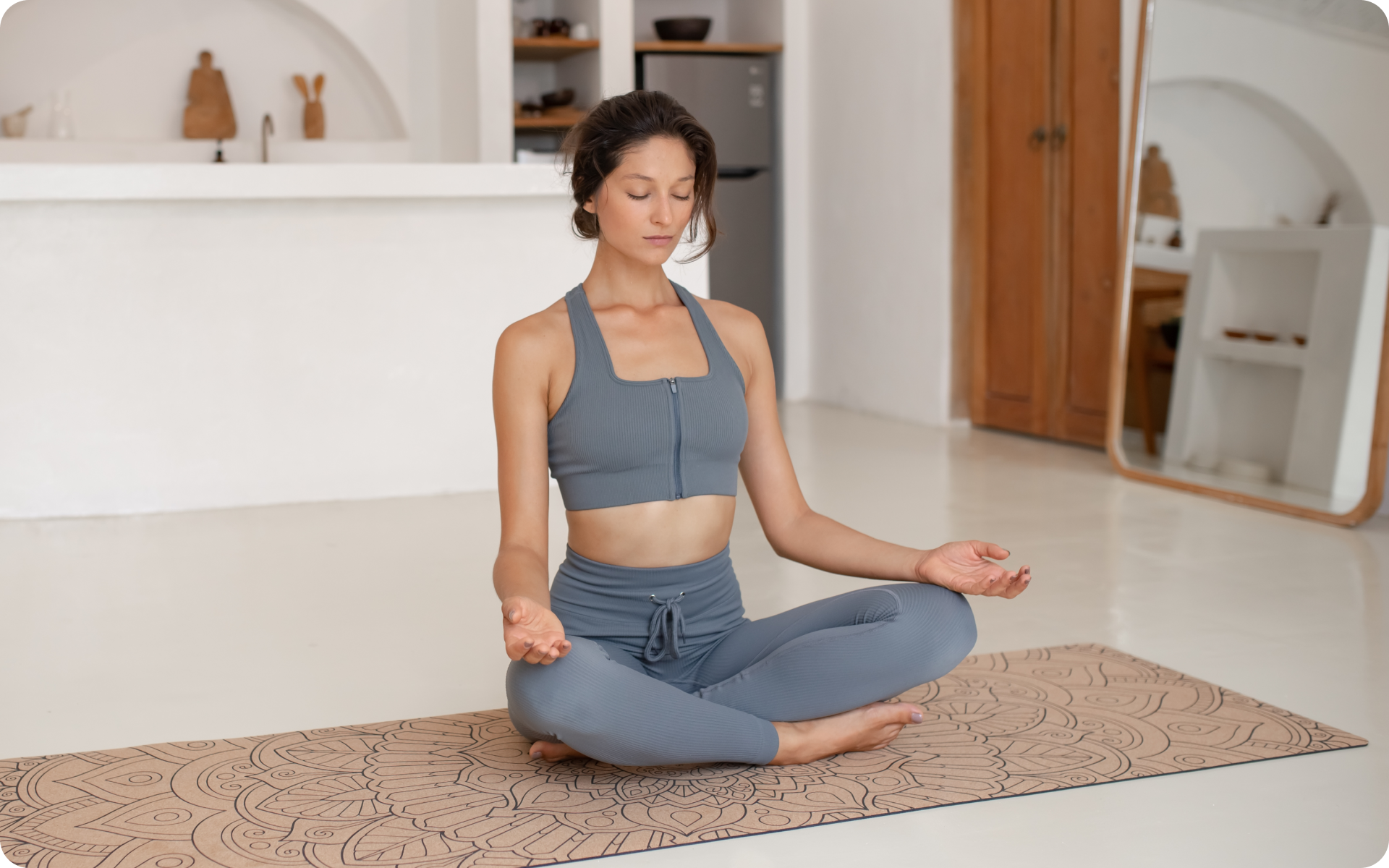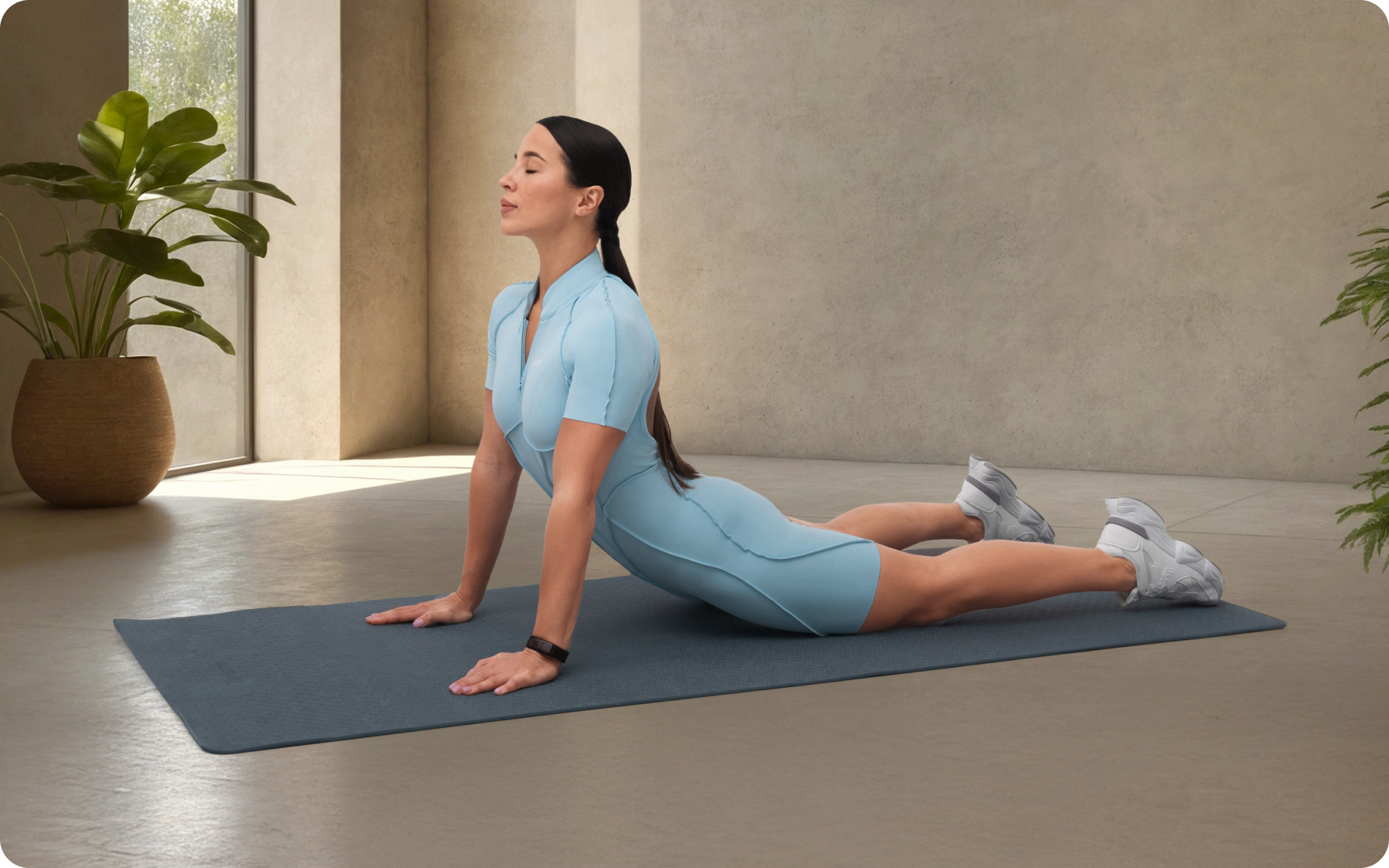A wandering mind can get in the way of achieving a state of mindfulness, tranquility, and focus that meditation promises. Most beginners struggle to rein in their thoughts, often finding themselves lost in a labyrinth of worries, plans, or memories.
Even with experience, it’s totally natural to find yourself grappling with the challenge of maintaining focus.
Somatic meditation provides an interesting solution to this ubiquitous problem. It is a technique that emphasizes awareness of physical sensations and the perception of bodily experiences in the present moment as a means of improving the mind-body connection.
Research into this specific style of meditation is not as extensive as it is with more traditional forms, but anecdotal (experience-based) evidence suggests that this method can be particularly beneficial.
Research on mindfulness has suggested that it makes potential improvements to stress management, emotional regulation, and overall well-being (2).
Here’s everything you need to know about somatic meditation: its definition, the benefits it offers, and how you can practice it.
What Is Somatic Meditation?
Somatic meditation is rooted in the belief that our bodies are not just vehicles for our brains, but are deeply integrated elements of our being. In more traditional forms of meditation, the focus is often on the mind, with individuals striving to achieve a state of mental calm (15).
However, somatic meditation flips this approach, placing the body at the center of the practice. Instead of seeking to quiet the mind directly, somatic meditation encourages a bottom-up approach where you tune into the physical sensations of your body.
Practitioners often incorporate talk therapy, mind-body exercises, and physical techniques with somatic meditation.
These sensations can be as subtle as the feeling of your breath on the tip of your nose or as pronounced as the tension in your shoulders. By directing attention toward these physical experiences, the mind can naturally quieten down.
This approach is particularly useful for enhancing physical, emotional, and mental well-being.
Something tells us you often forget to put all the everyday hustle and bustle on hold and simply concentrate on yourself. It’s time to straighten out your priorities! Take a moment to heal, process your emotions, ground yourself, release all the pent-up tension and recharge with the BetterMe: Meditation & Sleep app before getting back into the race of life!
What Are The Practices of Somatic Meditation?
There are several specific practices that fall under the umbrella of somatic-based meditation, each of which is focused on building awareness of bodily sensations and experiences and improving the mind-body connection.
Body Scan Meditation
This practice stems from mindfulness-based stress reduction (MBSR) and involves systematically directing your attention to different parts of your body, from your toes to your head.
As you focus on each part, you will observe any sensations that arise, whether they’re tension, warmth, tingling, or even the absence of sensation. This practice fosters a deep connection with your body by staying present with and breathing into these sensations which can help provide relief for our minds (4).
Breath Awareness Meditation
This practice is focused on the sensation of breathing. You focus on the physical experience of inhaling and exhaling, noticing how your chest, belly, and nostrils move with every breath. This method anchors you in the present moment and can help reduce stress and anxiety (4).
Walking Meditation
Also known as Kinhin in Zen traditions, this practice involves mindful walking where you focus on the sensation of your feet touching the ground, the movement of your legs, and your balance. This form of meditation has been proven to reduce anxiety, depression, and disease severity in Parkinson’s disease. (3).
Yoga Nidra
Sometimes referred to as ‘yogic sleep’, yoga nidra is a form of guided somatic-based meditation that induces deep relaxation. You lie down and follow the guide’s instructions, typically starting with a body scan and then moving into more profound stages of relaxation and awareness (12).
What Are The Benefits of Somatic Meditation?
Somatic meditation offers a unique set of benefits that set it apart from more traditional forms of meditation.
This practice emphasizes the body’s physical sensations and can provide a more accessible pathway to mindfulness, particularly for those who struggle with mental chatter during meditation.
Here are some benefits you can look forward to when you practice somatic meditation:
Enhanced Mind-Body Connection
Somatic meditation can create an intimate conversation between your mind and body. By tuning into your physical sensations, you will develop a deeper understanding of your body’s language, which results in a more harmonious mind-body relationship (1).
More Effective Trauma Management
When combined with other psychotherapies such as somatic experiencing therapy, somatic meditation has the potential to be a tool for processing and healing traumatic experiences that are held in the body.
By focusing on physical sensations, somatic meditation helps in grounding, which allows individuals to progressively work through traumatic memories in a safe and measured manner (11).
It is important to note that without appropriate guidance, somatic meditation can be more of a stressor than a support for some people, and result in re-traumatization. Therefore, if you have experienced a traumatic event, you should seek the guidance of a trained therapist before you attempt somatic meditation.
Lower Likelihood of Suffering from Stress and Anxiety
The incorporation of somatic meditation for stress and anxiety can be an effective tool in your mental health arsenal.
Somatic-based meditation such as yoga nidra helps regulate the fight or flight response, which is often hyperactive in anxiety disorders, and promotes calm and relaxation (12).
We discuss additional low-impact ways of handling stress and anxiety in our chair yoga for stress relief article.
Improved Sleep
Somatic meditation for sleep encourages a deep sense of relaxation and facilitates the transition into a peaceful slumber. By bringing awareness to the body and releasing pent-up tensions, somatic meditation can help create the ideal conditions for restful sleep(13).
Pain Reduction
Somatic meditation for pain harnesses the power of body awareness, which can shift your relationship to pain, potentially reducing its intensity. By focusing on the body, somatic meditation can help you become more attuned to your pain sensations and work towards managing it more effectively (4).
Read more: Somatic Techniques for a Health Body and a Happy Mind
What Can You Expect from a Somatic Meditation Session?
A typical somatic meditation session may unfold as follows:
Find a Comfortable Position
Unlike other forms of meditation, you are not required to sit in a cross-legged position for somatic meditation. Instead, you should find a position that enables you to be most aware of your body. This may be sitting, lying down, or standing. It’s important that you are comfortable and able to relax. Your hands can rest gently in your lap or by your side.
Close Your Eyes and Start Breathing Deeply
Once you are settled, close your eyes and start taking slow, deep breaths. Breathe in fully through your nose and exhale slowly through your nose or mouth. Feel your stomach expand like a balloon on an inhale and relax and let go as you exhale.
Scan Your Body
If you are distracted by sounds in the room, simply notice this and bring your focus back to your breathing. Start a slow scan of your body, starting from your toes and moving upwards. You may want to wiggle your toes a little and feel any sensations without judgment.
Pay attention to any sensations you feel along the way as you move your attention up to your ankles, calves, knees, and thighs. This could be a sense of relaxation, tension, discomfort, or even neutrality. Do not judge or try to change these sensations – simply observe them. Slowly move your attention to the sensations in your lower back and pelvis, and then to your mid-back and upper back until you reach your head.
If your mind starts to wander, gently bring it back to the sensations of the area. Remember to keep breathing in and out as you move to the next area of your body.
Focus on Sensations
As you scan your body, you may notice certain sensations that are more powerful than others. This could be a tightness in your chest, a tingling in your fingers, or a heaviness in your legs. Whenever you identify one, spend some time focusing on it. Again, do not attempt to alter the sensation, merely observe and acknowledge its presence without judgment.
Integration
Once you have scanned your entire body, spend a few moments simply lying or sitting in silence, which will allow your body and mind to integrate the experience. Bring into your awareness the top of your head down to the bottom of your toes. Feel the gentle rhythm of your breath as it moves through the body. You may notice a sense of peace, relaxation, or relief.
Return to the Physical World
When you feel ready, slowly bring your awareness back to the room. Take a full, deep breath, taking in all the energy of this practice before exhaling fully. Wiggle your fingers and toes, stretch your arms and legs, and when you are ready, slowly open your eyes.
During a somatic meditation session, you may experience a variety of sensations and emotions. The key is to observe them without judgment or resistance.
Over time, you may notice an enhanced ability to perceive subtle bodily sensations, a deepening sense of connection with your body, and an overall increase in mindfulness and well-being.
Following a somatic meditation session, it is common to feel a sense of calm and relaxation. You may also notice a greater sense of connection with your body.
With consistent practice, somatic meditation can lead to long-term benefits such as improved sleep, reduced anxiety, resolved traumatic memories, enhanced mind-body integration, and potentially pain reduction.
Every individual’s experience with somatic meditation is unique. The sensations, emotions, and benefits you experience may vary greatly from those of another person.
This is completely normal and is a reflection of your unique body and mind. It is recommended that you approach somatic meditation with an open mind and a readiness to accept whatever comes your way.
It should be noted that without appropriate guidance, somatic meditation can be more of a stressor than a support for some people, and this can cause re-traumatization. Therefore, if you have experienced a traumatic event, you should seek guidance from a trained therapist before you attempt somatic meditation.
With stress being a constant presence in our lives, taking time to process emotions, decompress and get into the right frame of mind is absolutely crucial. With BetterMe: Meditation & Sleep app your mental health is in good hands! Start using it now!
Can Somatic-Based Meditation Help with Trauma Healing?
People who seek out somatic therapy often have unresolved emotions that are linked to their experience of a traumatic event. According to the American Psychological Association, the definition of trauma is an emotional response to a terrible event such as an accident, rape, or natural disaster.
The traumatic event can be a one-time event, a prolonged series of events, or chronic, lasting stress. If trauma is not addressed, this can lead to long-term consequences, such as post-traumatic stress disorder (PTSD) (10).
When using somatic meditation to release ‘trapped’ emotions that are linked to a traumatic event, this should be guided by a trained therapist. The therapist may combine somatic-based meditation techniques with other psychotherapies in the session to help enhance body awareness and release pent-up emotions.
Read more: Somatic Practices: What They Are and How They Work
Frequently Asked Questions
Is yoga a somatic exercise?
No, but while yoga is not classified as a somatic exercise, it does incorporate elements of somatic practices. Yoga emphasizes the mind-body connection, encourages mindfulness, and involves tuning into your body’s sensations, which is similar to somatic exercises.
However, somatic exercises focus solely on internal physical perceptions and sensations, whereas yoga also involves achieving specific physical postures and incorporates spiritual and philosophical aspects.
Therefore, while they share similarities, yoga and somatic exercises are distinct practices with their own unique approaches and goals.
Are somatic exercises safe?
Somatic exercises are safe for most people. These exercises are typically gentle and aim to increase body awareness and comfort.
However, if you have any pre-existing conditions or health concerns, it is important that you consult your doctor before you start somatic exercise practice.
In addition, if you experience any discomfort while you are performing somatic exercises, you should stop and rest until the sensation passes and/or seek professional support.
Is there touching in somatic therapy?
Touching can be a component of some forms of somatic therapy. However, the degree and nature of touching are dependent on the specific therapy method and the therapist. It is always conducted in a professional manner and with the informed consent of the patient.
Can meditation heal trauma?
Meditation, particularly practices such as somatic meditation, can be a powerful tool for healing traumatic memories. It can help individuals reconnect with their bodies, manage stress, and cultivate mindfulness.
However, it’s important to note that while meditation can support trauma healing, it is generally most effective when it is used in conjunction with other therapies and under professional guidance.
How long does somatic therapy take?
The duration of somatic therapy varies widely depending on the individual and the nature of the issues that are being addressed.
Some people may notice changes after just a few sessions, while others may require longer-term therapy that lasts for several months or even years. It is a highly individual process and progress is often gradual.
The Bottom Line
Somatic meditation is the practice of using internal physical cues, such as breath and body sensations, to connect with the present moment and cultivate mind-body awareness.
Research has suggested that somatic meditation may have multiple benefits, including improved sleep, reduced anxiety, resolved traumatic memories, enhanced mind-body integration, and pain reduction.
If you’re interested in trying somatic meditation, you should consider finding a qualified practitioner or attending classes. Meditating under the guidance of professionals can ensure that your practice is safe and effective.
DISCLAIMER:
This article is intended for general informational purposes only and does not serve to address individual circumstances. It is not a substitute for professional advice or help and should not be relied on for making any kind of decision-making. Any action taken as a direct or indirect result of the information in this article is entirely at your own risk and is your sole responsibility.
BetterMe, its content staff, and its medical advisors accept no responsibility for inaccuracies, errors, misstatements, inconsistencies, or omissions and specifically disclaim any liability, loss or risk, personal, professional or otherwise, which may be incurred as a consequence, directly or indirectly, of the use and/or application of any content.
You should always seek the advice of your physician or other qualified health provider with any questions you may have regarding a medical condition or your specific situation. Never disregard professional medical advice or delay seeking it because of BetterMe content. If you suspect or think you may have a medical emergency, call your doctor.
SOURCES:
- Body Scan Meditation (2021,verywellmind.com)
- Effects of Mindfulness on Psychological Health: A Review of Empirical Studies (2013,nih.gov)
- Experimental effects of brief, single bouts of walking and meditation on mood profile in young adults (2018,nih.gov)
- Effectiveness of Somatic Yoga and Meditation: A Pilot Study in a Multicultural Cancer Survivor Population with Chemotherapy-Induced Peripheral Neuropathy (2019,allenpress.com)
- Improvement of Interoceptive Processes after an 8-Week Body Scan Intervention (2017,frontiersin.org)
- Mindfulness, Interoception, and the Body: A Contemporary Perspective (2019,nih.gov)
- Mindfulness Meditation (2023,dhs.gov)
- Moving With Pain: What Principles From Somatic Practices Can Offer to People Living With Chronic Pain (2021,nih.gov)
- Progressive Muscle Relaxation (2021,va.gov)
- Somatic Experiencing for Posttraumatic Stress Disorder: A Randomized Controlled Outcome Study (2017,nih.gov)
- The Body Scan and Mindful Breathing Among Veterans with PTSD: Type of Intervention Moderates the Relationship Between Changes in Mindfulness and Post-treatment Depression (2020,nih.gov)
- The Origin and Clinical Relevance of Yoga Nidra (2022,nih.gov)
- The Contribution of a Body Scan Mindfulness Meditation to Effectiveness of Internet-Delivered CBT for Insomnia in Adolescents (2021,.springer.com)
- Vipassana meditation: (2001,nih.gov)
- WHAT IS SOMATIC MEDITATION? ( n,d,dharmaocean.org)












